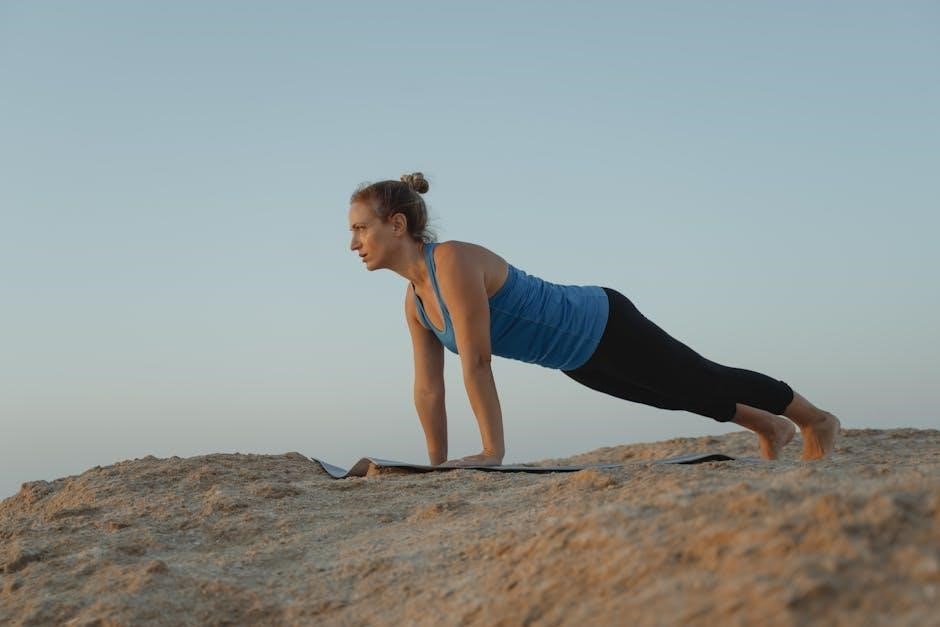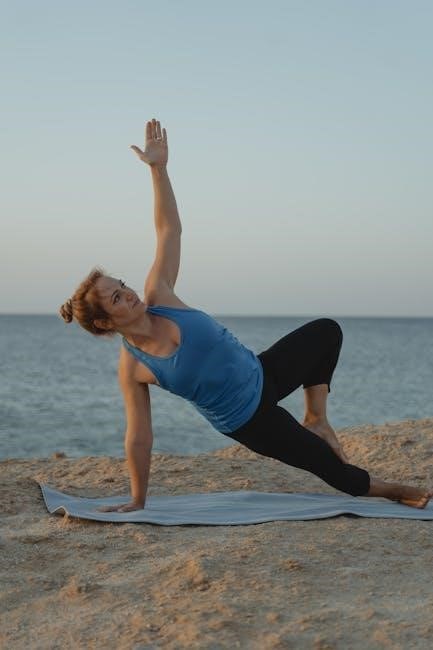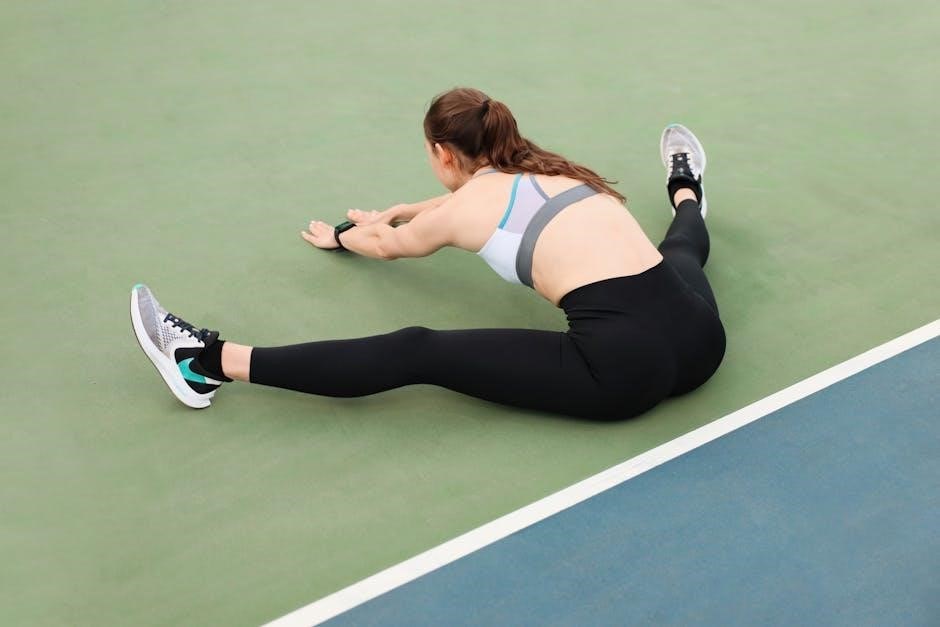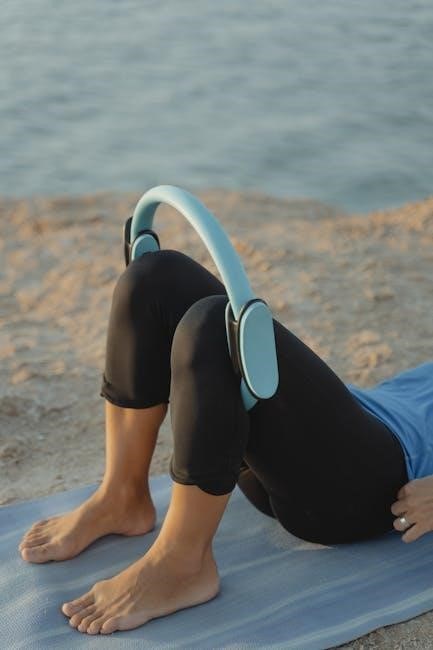Diastasis recti is a common post-pregnancy condition where abdominal muscles separate, affecting core stability and posture. It often requires targeted exercises to strengthen deep muscles like the transverse abdominis for effective recovery and improved functionality.
What is Diastasis Recti?
Diastasis Recti, meaning separation of the rectus abdominis muscle, occurs when the abdominal muscles split, often during or after pregnancy. This condition leads to a visible bulge or protrusion in the abdomen, particularly noticeable during activities like coughing or straining. It can cause lower back pain and poor posture due to weakened core support. Diagnosis involves a self-test where lying on the back and lifting the head reveals a gap between the abdominal muscles. The severity varies, with treatment typically involving targeted exercises such as planks and pelvic tilts to strengthen the core. Supportive clothing or braces may also be recommended. In severe cases, surgery might be considered. Diastasis Recti impacts daily life, affecting both physical health and self-esteem, emphasizing the importance of exercise and proper management for recovery and well-being.
How to Check for Diastasis Recti
To check for Diastasis Recti, begin by lying on your back with your knees bent and feet flat on the floor. Engage your core by gently pulling your belly button towards your spine. Slowly lift your head and shoulders off the ground, maintaining a neutral spine. With your fingers placed horizontally across your abdomen, just below the belly button, feel for any gaps or soft spots between the abdominal muscles. A separation wider than two fingers indicates Diastasis Recti. Repeat this process at different points along your abdomen to assess the extent of the separation. If unsure, consider consulting a healthcare professional for an accurate diagnosis and guidance on appropriate exercises and treatments.

Understanding the Causes and Risk Factors
Diastasis Recti often stems from pregnancy, where hormonal changes and increased abdominal pressure cause muscle separation. Risk factors include multiple pregnancies, C-sections, and weak core muscles, making it crucial to address with targeted exercises.
Causes of Diastasis Recti
Diastasis Recti primarily occurs due to increased intra-abdominal pressure, often during pregnancy, which stretches the connective tissue (linea alba) between the abdominal muscles. Hormonal changes, such as increased relaxin, weaken these tissues, making separation more likely; Multiple pregnancies, carrying multiples, or C-sections can exacerbate this condition. Additionally, poor posture, chronic coughing, or heavy lifting may contribute to muscle separation. Postpartum, weakened core muscles further destabilize the abdominal wall, leading to a visible bulge or separation. Understanding these causes helps in developing targeted exercises to strengthen the transverse abdominis and restore core stability, which are essential for recovery and preventing further separation.
Risk Factors for Developing Diastasis Recti
Several factors increase the likelihood of developing diastasis recti, particularly in postpartum women. Multiple pregnancies and carrying multiples strain the abdominal wall, while C-sections or abdominal surgeries weaken the core muscles. Advanced maternal age and excessive weight gain during pregnancy also contribute to muscle separation. Additionally, poor posture, chronic coughing, or repetitive heavy lifting can exacerbate the condition. Women with a family history of diastasis recti or those who had it in previous pregnancies are at higher risk. These factors highlight the importance of proactive core strengthening exercises to mitigate the risk and support recovery. Understanding these risk factors can guide individuals in adopting preventive measures and seeking early intervention if symptoms arise.

Key Principles of Exercises for Diastasis Recti
Effective exercises for diastasis recti focus on strengthening the transverse abdominis and deep core muscles. They emphasize controlled movements, proper breathing, and avoiding exercises that strain the abdominal wall or cause bulging.
The Role of Transverse Abdominis in Diastasis Recti Exercises
The transverse abdominis muscle plays a crucial role in diastasis recti exercises by acting as the body’s natural corset. Engaging this muscle helps stabilize the spine and pelvis, reducing the gap between the abdominal muscles. By strengthening the transverse abdominis, individuals can improve core stability, enhance posture, and support the healing process. This muscle is activated through specific exercises like the abdominal drawing-in maneuver, pelvic tilts, and modified planks. Consistent engagement of the transverse abdominis helps restore proper abdominal function and reduces the risk of further separation. It is essential to focus on controlled movements and proper breathing techniques to maximize the effectiveness of these exercises. Over time, strengthening the transverse abdominis contributes to a stronger, more functional core, which is vital for overall physical stability and preventing future complications related to diastasis recti.
What to Avoid in Diastasis Recti Exercises

When addressing diastasis recti, it is crucial to avoid exercises that put additional strain on the abdominal wall. Activities such as crunches, sit-ups, and planks can exacerbate the separation by increasing intra-abdominal pressure. Heavy lifting, bending, or any movement that causes the abdomen to bulge should also be avoided. High-intensity exercises that target the external abdominal muscles, such as leg raises or oblique twists, can worsen the condition. Additionally, avoid exercises that involve deep backbends or excessive stretching of the abdominal area. It is also important to refrain from any activity that causes discomfort or pain in the abdominal region. Proper breathing techniques and engagement of the transverse abdominis muscle are essential to avoid further strain. By avoiding these exercises, individuals can reduce the risk of aggravating diastasis recti and promote a safer, more effective recovery process.

Most Effective Exercises for Diastasis Recti
Effective exercises include the abdominal drawing-in maneuver, pelvic tilts, and modified planks, which target the transverse abdominis muscle to improve core stability and reduce abdominal separation.
Pelvic Tilt Exercise for Diastasis Recti
The pelvic tilt exercise is a gentle, effective movement that targets the deep abdominal muscles and promotes core stability. To perform it, lie on your back with knees bent and feet flat on the floor. Engage your transverse abdominis by drawing your belly button toward your spine. Slowly tilt your pelvis upwards, flattening your lower back against the floor, then return to the starting position. Repeat for 10-15 repetitions, ensuring smooth, controlled movements. This exercise helps improve posture, reduce separation, and strengthen the core without putting strain on the abdominal wall. It is often recommended as a foundational exercise in diastasis recti recovery programs due to its low-impact nature and effectiveness in re-engaging core muscles.
Abdominal Drawing-In Maneuver
The Abdominal Drawing-In Maneuver (ADIM) is a foundational exercise for addressing diastasis recti. It targets the transverse abdominis, the deepest abdominal muscle, which acts as an inner corset to stabilize the spine and pelvis. To perform ADIM, lie on your back with knees bent and feet flat on the floor. Engage your core by gently drawing your belly button toward your spine, maintaining normal breathing. Hold for 5-10 seconds, then release. Repeat for 10-15 repetitions. This exercise strengthens the deep core muscles without putting strain on the abdominal wall, making it ideal for early stages of recovery. Regular practice improves posture, reduces muscle separation, and enhances overall core stability. It is often combined with other exercises, such as pelvic tilts, to create a comprehensive diastasis recti recovery program. Consistency is key to achieving long-term benefits and supporting the healing of the abdominal muscles.
Bird-Dog Exercise for Core Stability
The Bird-Dog exercise is an effective movement for improving core stability, particularly beneficial for individuals with diastasis recti. It targets the transverse abdominis muscle, which plays a crucial role in stabilizing the spine and pelvis. To perform the exercise, start on your hands and knees in a tabletop position. Engage your core by drawing your belly button toward your spine. Slowly extend your right arm forward and your left leg backward, keeping them aligned with your torso. Hold for a few seconds, then return to the starting position. Alternate sides for 8-12 repetitions. This exercise enhances coordination, strength, and posture while minimizing strain on the abdominal wall. Proper form is essential to avoid exacerbating muscle separation. Consistent practice can help restore core function and reduce diastasis recti symptoms, promoting a stronger, more stable foundation for daily activities.
Modified Plank Exercises for Diastasis Recti
Modified plank exercises are a safe and effective way to strengthen the core without putting excessive strain on the abdominal wall, making them ideal for individuals with diastasis recti. These exercises focus on engaging the transverse abdominis muscle, which helps stabilize the pelvis and spine. To perform a modified plank, start by kneeling on a mat with your hands under your shoulders. Engage your core by drawing your belly button toward your spine, ensuring your hips remain aligned with your shoulders. Avoid allowing your hips to sag or your back to arch. Hold this position for 10-20 seconds, gradually increasing the duration as your strength improves. Variations, such as wall planks or incline planks, can reduce pressure on the abdominal muscles while still providing a challenging workout. Consistent practice can help improve posture, reduce discomfort, and support the recovery process for those with diastasis recti.

Additional Beneficial Exercises
Gentle stretching and modified movements, such as seated stretches or side bends, can complement core work by improving flexibility and reducing muscle tension. These exercises support recovery without straining the abdominal wall.
Pelvic Floor Muscle Exercises
Pelvic floor muscle exercises, also known as Kegels, are essential for strengthening the muscles that support the bladder, uterus, and bowels. These exercises are particularly beneficial during postpartum recovery, as they help restore the integrity of the pelvic floor, which can be weakened by pregnancy and childbirth. To perform Kegels effectively, individuals should sit or lie in a comfortable position and engage the pelvic floor muscles as if stopping the flow of urine. Holding for 5-10 seconds and releasing slowly can enhance muscle tone. Regular practice can improve bladder control, reduce the risk of prolapse, and enhance overall core stability, which is crucial for managing diastasis recti. Incorporating these exercises into a daily routine can lead to noticeable improvements in both pelvic floor strength and abdominal alignment. Consistency is key to achieving long-term benefits and supporting the body’s postpartum healing process.
Deep Core Stability Exercises
Deep core stability exercises focus on activating the transverse abdominis muscle, which acts as an internal corset, providing essential support to the spine and abdominal wall. Strengthening this muscle is crucial for individuals with diastasis recti, as it helps reduce the separation of the abdominal muscles and improves overall core function. One effective exercise is the abdominal drawing-in maneuver, where the individual lies on their back, engages the transverse abdominis by gently drawing the belly button toward the spine, and holds for several breaths. Other exercises, such as bird-dog and modified planks, also target deep core stability by promoting proper alignment and engagement of the core muscles. Performing these exercises with proper form and consistency can enhance posture, reduce back pain, and support the healing process of diastasis recti. Incorporating deep core stability exercises into a daily routine is vital for achieving long-term improvements in core strength and abdominal integrity.
Gentle Stretching Exercises for Diastasis Recti

Gentle stretching exercises play a supportive role in managing diastasis recti by improving flexibility and reducing muscle tension without putting strain on the abdominal wall. Cat-cow stretches and child’s pose are excellent options, as they promote spinal mobility and relieve tightness in the abdominal and pelvic regions. Pelvic tilts can also be beneficial, as they gently engage the core and improve posture. These stretches should be performed with controlled movements, avoiding any excessive force or pressure on the midline. Incorporating gentle yoga poses, such as seated forward folds or side stretches, can further enhance flexibility and comfort. It’s important to modify stretches based on individual comfort levels and avoid any exercises that cause discomfort or bulging of the abdominal muscles. Stretching should always be paired with strengthening exercises to ensure a balanced approach to managing diastasis recti effectively.

Lifestyle Tips to Support Recovery
Adopting good posture, practicing deep breathing, and wearing supportive clothing can aid recovery. A balanced diet, stress management, and avoiding heavy lifting are also crucial for healing and reducing diastasis recti symptoms effectively.
Postural Alignment and Breathing Techniques
Proper postural alignment is essential for reducing strain on the abdominal muscles and promoting healing. Standing or sitting tall with shoulders relaxed and pelvis in a neutral position can help distribute pressure evenly across the core. Deep breathing exercises, such as diaphragmatic breathing, engage the transverse abdominis muscle, providing additional support to the abdominal wall. By inhaling deeply through the nose and exhaling slowly through the mouth, individuals can strengthen their core and improve posture. These techniques are particularly beneficial when combined with exercises like the abdominal drawing-in maneuver. Maintaining good posture and practicing conscious breathing can also enhance overall physical stability and reduce the risk of further muscle separation. Incorporating these practices into daily routines supports long-term recovery and core strength.
Nutrition and Weight Management for Diastasis Recti Recovery
Nutrition plays a critical role in supporting the healing and recovery of diastasis recti. A balanced diet rich in protein, fiber, and essential nutrients helps strengthen connective tissue and promote muscle repair. Incorporating foods high in omega-3 fatty acids, such as fish and flaxseeds, can reduce inflammation, while vitamin C-rich foods like citrus fruits and leafy greens support collagen production. Maintaining a healthy weight through portion control and regular physical activity reduces abdominal pressure, minimizing further strain on the abdominal wall. Avoiding processed foods and sugary snacks helps prevent excessive weight gain, which can exacerbate the condition. Staying hydrated is also crucial for maintaining skin elasticity and overall tissue health. By focusing on whole, nutrient-dense foods, individuals can create an optimal environment for recovery and core strengthening exercises to be more effective.

When to Seek Professional Help
Consult a healthcare professional if you experience persistent back pain, pelvic floor issues, or significant abdominal separation. Seek help if self-care measures fail to improve symptoms or if you suspect severe diastasis recti.
Signs That You Need Professional Assistance
If you notice significant abdominal separation exceeding two fingers, seek professional help. Other signs include persistent back pain, pelvic floor dysfunction, or a visible bulge that worsens with movement. A healthcare provider can offer personalized treatment plans, including physical therapy or lifestyle modifications, to address these symptoms effectively. Early intervention is crucial for optimal recovery and preventing further complications.
Working with a Physical Therapist for Diastasis Recti
Collaborating with a physical therapist is essential for effectively managing diastasis recti. They specialize in creating personalized exercise programs tailored to your specific condition, focusing on strengthening the transverse abdominis and improving core stability. A physical therapist can guide you through safe and effective movements, ensuring proper form and progression. They also address postural alignment and breathing techniques to support healing. Additionally, they may incorporate manual therapy to promote connective tissue repair and reduce muscle imbalances. Regular sessions with a physical therapist can help restore abdominal function, alleviate symptoms like back pain, and enhance overall physical resilience. Their expertise ensures a structured and evidence-based approach to recovery, making them a vital resource for individuals with diastasis recti.

Preventing Future Separation
Preventing future separation involves strengthening core muscles, maintaining proper posture, and avoiding heavy lifting or strains. Consistent exercises like pelvic tilts and transverse abdominis engagement help stabilize the abdominal wall and reduce recurrence risk.
Strengthening the Core Post-Recovery
Strengthening the core post-recovery is essential for long-term stability and preventing future separation. Focus on deep abdominal muscles like the transverse abdominis, which act as an inner corset to support the spine and pelvis. Gentle exercises such as pelvic tilts, abdominal drawing-in maneuvers, and modified planks can help rebuild core strength without putting excessive strain on the abdominal wall.
Post-recovery, avoid movements that cause bulging or doming of the abdomen, as these can weaken the repair. Instead, prioritize controlled, low-intensity exercises that promote functional strength. Incorporating pelvic floor muscle exercises, such as Kegels, can further enhance core stability and overall pelvic health. Proper breathing techniques and postural alignment should also be integrated into daily activities to support the core and reduce the risk of re-separation.
Consistency is key. Gradually progress to more dynamic exercises, ensuring proper form and engagement of the deep core muscles. A well-rounded exercise program, combined with a healthy lifestyle and nutrition, will help maintain core strength and promote lasting recovery from diastasis recti.
Safe Exercise Practices During Pregnancy
During pregnancy, safe exercise practices are crucial to support core stability and reduce the risk of diastasis recti. Gentle exercises like pelvic tilts, deep breathing, and modified stretches can help strengthen the abdominal and pelvic floor muscles without overstraining. Avoid heavy lifting, high-intensity exercises, or movements that cause abdominal bulging or discomfort.
- Focus on low-impact activities such as walking, swimming, or prenatal yoga, which promote strength and flexibility safely.
- Incorporate exercises that engage the transverse abdominis, such as the abdominal drawing-in maneuver, to support the core.
- Maintain proper posture and breathing techniques to alleviate pressure on the abdominal wall.
Consulting a healthcare provider or physical therapist before starting any exercise routine is essential to ensure safety and effectiveness. Wearing supportive clothing and modifying exercises, such as avoiding traditional planks, can also help protect the abdominal muscles during pregnancy.
